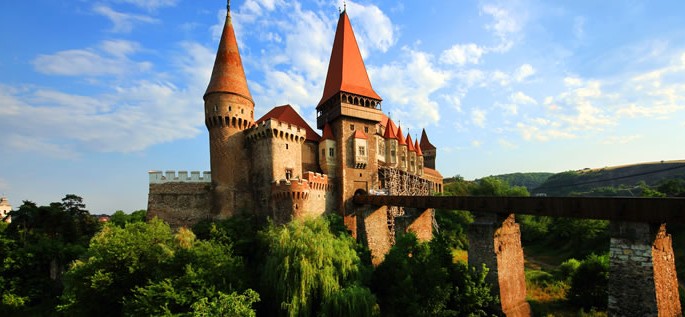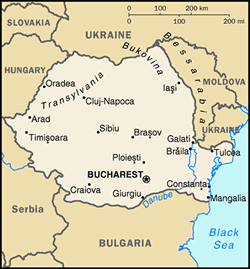
Romanian
Romanian (Romȃneşte), also called Daco-Rumanian, Moldavian, Rumanian, is the easternmost member of the Romance branch of the Indo-European language family. It is the statutory national language of Romania where it is spoken as a first language by 19.7 million people (Ethnologue). Romanian is also the official language of Moldova, a former Soviet republic, where it is called sometimes called Moldovan. It is spoken in Moldova by some 3 million people. Unlike Romanian of Romania written with the Latin alphabet, the Moldovan variety used Cyrillic until it was officially replaced by the Latin alphabet. Romanian has a large diaspora, being spoken in Australia, Azerbaijan, Bulgaria, Canada, Croatia, Czech Republic, Finland, Hungary, Israel, Kazakhstan, Kyrgyzstan, Russian Federation, Serbia, Sweden, Tajikistan, Turkmenistan, Ukraine, United States, and Uzbekistan. The total number of speakers worldwide is reported to be 26.3 million (Ethnologue).
Romanian developed from Vulgar Latin during the 5th-6th centuries when the territory which is now Romania was part of the Roman Empire. During the 7th and 8th centuries, Romanians came into contact with their Slavic speaking neighbors who exerted a great deal of influence on their language, religion, and culture. Other influences included Hungarian, Turkish, and Greek.
Status
Romania
Romanian is the statutory national language of Romania where it is spoken as a first language by 19.9 million people (Ethnologue). It is used in all aspects of private and public life. Education in Romanian is available from the elementary through the university level. It enjoys a vigorous publishing industry.
Moldova
Romanian is the official language of Moldova, a former Soviet republic, where it is called Moldovan. It is spoken in Moldova by some 2.6 million people who use it in all aspects of private and public life. Unlike Romanian of Romania which was always written with the Latin alphabet, Moldovan used Cyrillic until it was officially replaced by the Latin alphabet after Moldova gained independence from the former Soviet Union.
Dialects
The following dialects are reported by Ethnologue:
- Banat
- Bayash (dialect spoken by Gypsies and influenced by Balkan Romani and Hungarian)
- Moldavian (influenced by Russian and written with the Cyrillic alphabet)
- Muntenian (Walachian)
- Transylvanian
Structure
Sound system
The sound system of Romanian is characterized by a large inventory of vowels and diphthongs, and a relatively simple system of consonants.
Vowels
Romanian has seven vowel phonemes, i.e., sounds that differentiate word meaning. In addition, it has a number of diphthongs and triphthongs.
|
i
|
ɨ
|
u
|
|
|
e
|
ə
|
o
|
|
|
a
|
- /ɨ/ = e in roses (this vowel does not occur in any other Romance language, but it is common in Slavic languages such as Russian)
- /ə/ = a in about
Consonants
Romanian has 22 consonant phonemes, i.e., sounds that make a difference in word meaning.
| Stops | voiceless |
p
|
t
|
(k)
|
||||
| voiced |
b
|
d
|
g
|
|||||
| Fricatives | voiceless |
f
|
s
|
ʃ
|
.
|
h
|
||
| voiced |
v
|
z
|
ʒ
|
|||||
| Affricates | voiceless |
ts
|
tʃ
|
|||||
| voiced |
dʒ
|
|||||||
| Nasals |
m
|
n
|
||||||
| Lateral |
l
|
|||||||
| Trill or flap |
r
|
|||||||
| Approximants |
w
|
j
|
- /p, t, k/ are not aspirated, i.e., they are produced without a puff of air, as in English.
- /k/ occurs primarily in loan words.
- /ʃ/ = sh in shop
- /ʒ/ = s in vision
- /tʃ/ = ch in chat
- /dʒ/ = j in job
- /r/ can be trilled or flapped
Stress
Stress can occur on any syllable. Varying the position of stress can change the meaning of words, e.g., módele ‘the fahsions’ and modéle ‘models’. Stress is not normally marked in writing, except to distinguish between homographs.
Grammar
Romanian has preserved more of the Latin grammar than other Romance languages, possibly due to its relative isolation in the Balkans from other Romance languages, the existence of identical grammatical structures in the Dacian language spoken in the area that is now Romania, and the presence of similar structures in the neighboring languages.
Nouns, adjectives, articles, and pronouns
- Inanimate nouns have three grammatical genders: masculine, feminine, and neuter, e.g, bou ‘ox’ (masculine), carte ‘book’ (feminine), drum ‘road’ (neuter). Gender is only partially predictable from the shape of the noun. The grammatical gender of animate nouns coincides with sex, e.g., om ‘man’ (masculine), buniča ‘grandmother’ (feminine).
- There are two numbers: singular and plural. Plural is formed by adding –i to masculine and –e to feminine nouns.
- Unlike other Romance languages, Romanian has retained five cases: nominative, genitive, dative, accusative, and vocative. Nominative/accusative and genitive/dative share the same endings. The vocative case is rarely used.
- Due to the influence of other Balkan languages, such as Albanian and Greek, Romanian is the only Romance language that attaches the definite article to the end of a noun, e.g., frate ‘brother’ — fratele ‘the brother’. However, the indefinite article is placed before the noun, e.g., un copil ‘a child’.
- Adjectives agree with the nouns they modify in gender, number, and case. They follow the same declensional patterns as the nouns.
- Romanian distinguishes between tu and voi, the informal and formal second person pronouns, when addressing people.
Verbs
- Romanian verbs agree with their subjects in person (1st, 2nd, 3rd) and number (singular, plural). Personal subject pronouns are usually dropped, e.g.,fac ‘(I) do.’
- There are three to five conjugations, depending on the analysis.
- There are three simple tenses: present, past, future. Compound tenses are formed with auxiliary verbs. Future is periphrastic, formed with the auxiliary verbs voleo ‘wish’ or habeo ‘have to’.
- There are five moods: indicative, conditional, subjunctive, presumptive, imperative. Most moods have one or two tenses, while the indicative mood has eight tenses.
- There are three voices: active, passive, and reflexive.
Word order
The normal word order in Romanian sentences is Subject-Verb-Object although variations are possible. Adjectives normally follow the nouns they modify, e.g.,un student bun ‘a good student’.
Vocabulary
As is the case with other Romance languages, Romanian vocabulary is mostly of Latin origin. However, it has many Slavic elements with an estimated 40% of Romanian vocabulary consisting of borrowings from neighboring Slavic languages. In the 19th century, there was a determined effort to purge Romanian of Slavic words and replace them with Romance vocabulary. Much of the ‘reromancing’ was due to the rise of French as a cultural model. Romanian also has many borrowings from Greek, Hungarian, Turkish, and most recently from English.
Below are some common expressions and words in Romanian.
| Hello. | Bună ziua. |
| Good bye. | La revedere. |
| Please. | Vă rog. |
| Thank you. | Mulțumesc. |
| Excuse me. | Scuză-mă. |
| Yes. | Da. |
| No. | Nu. |
| Man. | Om. |
| Woman | Femeie. |
Below are the numerals 1-10 in Romanian.
|
1
|
2
|
3
|
4
|
5
|
6
|
7
|
8
|
9
|
10
|
|---|---|---|---|---|---|---|---|---|---|
|
unu
|
doi
|
trei
|
patru
|
cinci
|
şase
|
şapte
|
opt
|
nouă
|
zece
|
Writing
The earliest written text in Romanian dates back to 1521. It was written with the Old Church Slavonic alphabet. From the late 16th century, a version of the Latin alphabet, using Hungarian spelling conventions, was used to write Romanian in Transylvania. In the late 18th century, a spelling system based on Italian was adopted. An adapted version of the Cyrillic alphabet was used in the Soviet Republic of Moldova until 1989, when it was replaced by the Latin alphabet used in Romania. The Cyrillic alphabet was not a good fit for Romanian. However, many Moldovans, educated during the Soviet period, still tend to use the Cyrillic alphabet.
Below is the standard Romanian alphabet used today.
|
Latin alphabet for Romanian
|
|||||||||||||||
|---|---|---|---|---|---|---|---|---|---|---|---|---|---|---|---|
|
A a
|
Ă ă
|
Ȃ ȃ
|
B b
|
C c
|
D d
|
E e
|
F f
|
G g
|
H h
|
I i
|
Ȋ ȋ
|
J j
|
K k
|
L l
|
M m
|
|
N n
|
O o
|
P p
|
Q q
|
R r
|
S s
|
Ş ş
|
T t
|
Ț ț
|
U u
|
V v
|
W w
|
X x
|
Y y
|
Z z
|
|
- ă = /ə/ pronounced like a in about.
- ȃ, ȋ = /ɨ/ no equivalent in English.
- ş = sh in shop
- ț = ts in cats
- ce, ci = ch in chat
- ge, gi = j in jam
- che, chi = k in keen
- ghe, ghi = g in geese
Take a look at Article 1 of the Universal Declaration of Human Rights in Romanian Latin and Moldovan Cyrillic scripts.
| Declarația universală a drepturilor omului Articolul 1 Toate ființele umane se nasc libere şi egale ȋn demnitate şi ȋn drepturi. Ele ȋnzestrațe cu rațune şi conştiință şi trebuie să se comporte unele față de altele ȋn spiritul fraternității. |
| Universal Declaration of Human Rights Article 1 All human beings are born free and equal in dignity and rights. They are endowed with reason and conscience and should act towards one another in a spirit of brotherhood. |
Did You Know?
Here are two Romanian loanwords in English:
| Dracula | ‘king of the vampires’ in Bram Stoker‘s novel (1897). It was a nickname of Prince Vlad of Wallachia (d.1476). The name ‘Dracula’ comes from a secret fraternal order of knights called the Order of the Dragon. Vlad III’s father was admitted to the Order c. 1431. The word for ‘dragon’ in Romanian is drac and ul is the masculine form of the definite article. Vlad III’s father was known as Vlad Dracul, or ‘Vlad the dragon.’ Vlad III thus became Vlad Dracula, or ‘the son of the dragon.’ (Wikipedia). |
| pastrami | via Yiddish, from Rumanian pastrama, probably from Turkish pastrima, ‘dried meat’ |
Difficulty
 How difficult is it to learn Romanian?
How difficult is it to learn Romanian?Romanian is considered to be a Category I language in terms of difficulty for speakers of English.
